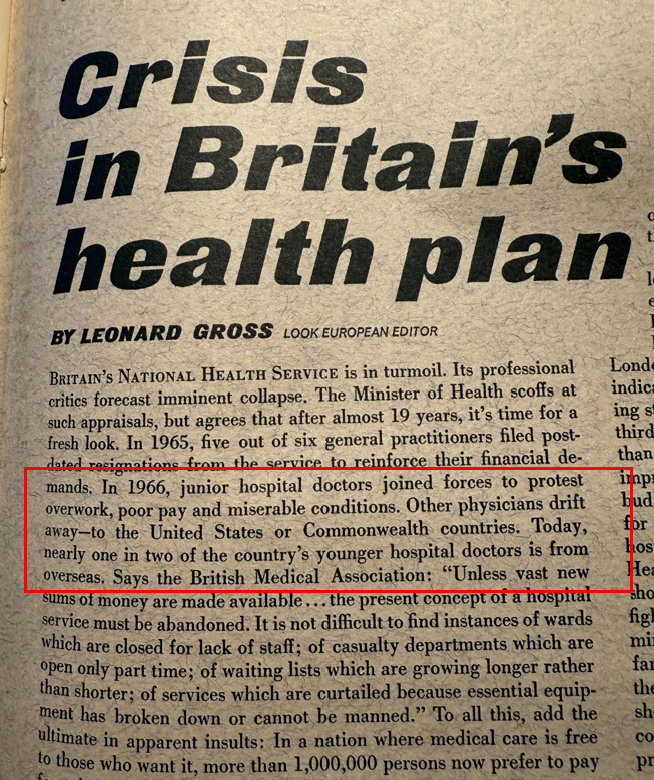
Nonuniversity level 1 trauma/critical care/general surgeon. ECMO service. PGY-27. Father of 4. Surgical instrument threads. History enthusiast. Robot centrist.
16 subscribers
How to get URL link on X (Twitter) App


 It has always been the case that though much of the conversation has to do with pay, that the true causes of discontent are more complex than that. Again, this was noted more than 50 years ago:
It has always been the case that though much of the conversation has to do with pay, that the true causes of discontent are more complex than that. Again, this was noted more than 50 years ago: 


 Formal vascular repair had been described by Carrel, but was impractical in war conditions due to practically all wounds having massive contamination and delayed presentation, which made the vessels more friable and difficult to suture.
Formal vascular repair had been described by Carrel, but was impractical in war conditions due to practically all wounds having massive contamination and delayed presentation, which made the vessels more friable and difficult to suture. 




 If you want your first knot to be square, you generally *don't* want to start off with uncrossed threads (L picture).
If you want your first knot to be square, you generally *don't* want to start off with uncrossed threads (L picture).


 Once again, we will make some assumptions here:
Once again, we will make some assumptions here:

 An Aberdeen knot can be used at the end of a continuous (running) suture as an alternative to a square knot.
An Aberdeen knot can be used at the end of a continuous (running) suture as an alternative to a square knot.



 Briefly:
Briefly:

 If you use the Bookwalter, you're aware that the tray comes with a large number of the standard 'clicky things' (officially: 'ratchets').
If you use the Bookwalter, you're aware that the tray comes with a large number of the standard 'clicky things' (officially: 'ratchets').


 In the mid 1970's, angiographic procedures started to be done using introducer sheaths, which were much more convenient than passing all the devices through vascular cutdowns, as before.
In the mid 1970's, angiographic procedures started to be done using introducer sheaths, which were much more convenient than passing all the devices through vascular cutdowns, as before.

 Frank Murphy was an anesthesiologist with interesting choices in facial hair that worked in various places (here seen at UCSF). At the time he devised his tubes, he was at Harper Hospital in Detroit.
Frank Murphy was an anesthesiologist with interesting choices in facial hair that worked in various places (here seen at UCSF). At the time he devised his tubes, he was at Harper Hospital in Detroit.

 One of the things Seldinger recommended was to push on the artery during the part when the wire is in to decrease bleeding. Most people skip this now, as the bleeding is usually fairly minor. Also it doesn;t make sense for locations such as the jugular vein.
One of the things Seldinger recommended was to push on the artery during the part when the wire is in to decrease bleeding. Most people skip this now, as the bleeding is usually fairly minor. Also it doesn;t make sense for locations such as the jugular vein. 

 Vicryl
Vicryl https://x.com/rbarbosa91/status/1595336136221937666


 In the earlier threads about 2-handed and 1-handed knot tying, we learned that creating a square knot consisted basically of creating a loop and bringing a strand through it.
In the earlier threads about 2-handed and 1-handed knot tying, we learned that creating a square knot consisted basically of creating a loop and bringing a strand through it.



 We are all familiar with the small plastic guide for the wire. It is meant to help you feed the wire into the needle.
We are all familiar with the small plastic guide for the wire. It is meant to help you feed the wire into the needle.


 Here is the original post from 6 weeks ago.
Here is the original post from 6 weeks ago.https://x.com/rbarbosa91/status/1793522294532485435


 If you just want the short version:
If you just want the short version:

 For this 🧵, I will use the words 'left' and 'right' instead of 'non-dominant' and 'dominant', respectively.
For this 🧵, I will use the words 'left' and 'right' instead of 'non-dominant' and 'dominant', respectively.


 Foley catheters have actually been used intracranially, believe it or not...😬
Foley catheters have actually been used intracranially, believe it or not...😬


 The origin of the term 'stay suture' is unclear, and other names may be used.
The origin of the term 'stay suture' is unclear, and other names may be used.


 Catgut has been used for suturing for many centuries, but it first became industrialized by the German company B Braun.
Catgut has been used for suturing for many centuries, but it first became industrialized by the German company B Braun.


 Background:
Background: